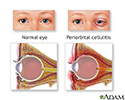Periorbital cellulitis
Preseptal cellulitis
Periorbital cellulitis is an infection of the eyelid or skin around the eye.
Causes
Periorbital cellulitis commonly affects children under 18 months old, though it can occur at any age.
This infection can occur after a scratch, injury, or bug bite around the eye, which allows germs to enter the wound. It can also extend from a nearby site that is infected, such as the sinuses.
Symptoms
Symptoms include:
- Redness around the eye or in the white part of the eye
- Swelling of the eyelid, whites of eyes, and surrounding area
This condition does not often affect vision or cause eye pain.
Exams and Tests
The health care provider will examine the eye and ask about the symptoms.
Tests that may be ordered include:
-
Blood culture
Blood culture
A blood culture is a laboratory test to check for bacteria or other germs in a blood sample.
Read Article Now Book Mark Article -
Blood tests (complete blood count)
Blood tests (complete blood count)
A complete blood count (CBC) test measures the following:The number of red blood cells (RBC count)The number of white blood cells (WBC count)The tota...
 ImageRead Article Now Book Mark Article
ImageRead Article Now Book Mark Article -
CT scan
CT scan
A computed tomography (CT) scan of the orbit is an imaging method. It uses x-rays to create detailed pictures of the eye sockets (orbits), eyes and ...
 ImageRead Article Now Book Mark Article
ImageRead Article Now Book Mark Article -
MRI scan
MRI scan
A head MRI (magnetic resonance imaging) is an imaging test that uses powerful magnets and radio waves to create pictures of the brain and surrounding...
 ImageRead Article Now Book Mark Article
ImageRead Article Now Book Mark Article
Treatment
Antibiotics are given by mouth, by shots, or through a vein (intravenously; IV) to help fight the infection.
Outlook (Prognosis)
Periorbital cellulitis almost always improves with treatment. In rare cases, the infection spreads into the eye socket, the tissues that surround the eye, and the eyeball itself. This infection is called orbital cellulitis .
Orbital cellulitis
Orbital cellulitis is an infection of the fat and muscles around the eye. It affects the eyelids, eyebrows, and cheeks. It may begin suddenly or be...

When to Contact a Medical Professional
Call your provider right away if:
- The eye becomes red or swollen
- Symptoms get worse after treatment
- Fever develops along with eye symptoms
- It is difficult or painful to move the eye
- The eye looks like it is sticking (bulging) out
- There are vision changes
References
Durand ML. Periocular infections. In: Bennett JE, Dolin R, Blaser MJ, eds. Mandell, Douglas, and Bennett's Principles and Practice of Infectious Diseases . 8th ed. Philadelphia, PA: Elsevier Saunders; 2015:chap 118.
Olitsky SE, Hug D, Plummer LS, Stahl ED, Ariss MM, Lindquist TP. Orbital infections. In: Kliegman RM, Stanton BF, St Geme JW III, Schor NF, eds. Nelson Textbook of Pediatrics . 20th ed. Philadelphia, PA: Elsevier; 2016:chap 634.
-
Haemophilus influenza organism - illustration
This picture shows the organism Haemophilus influenza. Infections caused by Haemophilus influenza usually occur in children under 6 years old and are extremely serious. Haemophilus (type B) is responsible for meningitis, periorbital cellulitis, buccal cellulitis and epiglottitis, septic arthritis, osteomyelitis, pericarditis, and bacteremia. The small organisms live within cells (intracellular) as shown in this picture. (Image courtesy of the Centers for Disease Control and Prevention.)
Haemophilus influenza organism
illustration
-
Periorbital cellulitis - illustration
Periorbital cellulitis is an acute infection of the tissues surrounding the eye, which may progress to orbital cellulitis with protrusion of the eyeball. Complications include meningitis.
Periorbital cellulitis
illustration
-
Haemophilus influenza organism - illustration
This is a Gram stain of spinal fluid from a person with meningitis. The rod-like organisms seen in the fluid are Haemophilus influenza, one of the most common causes of childhood meningitis (prior to the widespread use of the H influenza vaccine). The large red-colored objects are cells in the spinal fluid. A vaccine to prevent infection by Haemophilus influenza (type B) is available as one of the routine childhood immunizations (Hib), typically given at 2, 4 and 12 months.
Haemophilus influenza organism
illustration
-
Haemophilus influenza organism - illustration
This picture shows the organism Haemophilus influenza. Infections caused by Haemophilus influenza usually occur in children under 6 years old and are extremely serious. Haemophilus (type B) is responsible for meningitis, periorbital cellulitis, buccal cellulitis and epiglottitis, septic arthritis, osteomyelitis, pericarditis, and bacteremia. The small organisms live within cells (intracellular) as shown in this picture. (Image courtesy of the Centers for Disease Control and Prevention.)
Haemophilus influenza organism
illustration
-
Periorbital cellulitis - illustration
Periorbital cellulitis is an acute infection of the tissues surrounding the eye, which may progress to orbital cellulitis with protrusion of the eyeball. Complications include meningitis.
Periorbital cellulitis
illustration
-
Haemophilus influenza organism - illustration
This is a Gram stain of spinal fluid from a person with meningitis. The rod-like organisms seen in the fluid are Haemophilus influenza, one of the most common causes of childhood meningitis (prior to the widespread use of the H influenza vaccine). The large red-colored objects are cells in the spinal fluid. A vaccine to prevent infection by Haemophilus influenza (type B) is available as one of the routine childhood immunizations (Hib), typically given at 2, 4 and 12 months.
Haemophilus influenza organism
illustration
Review Date: 12/10/2015
Reviewed By: Jatin M. Vyas, MD, PhD, Assistant Professor in Medicine, Harvard Medical School; Assistant in Medicine, Division of Infectious Disease, Department of Medicine, Massachusetts General Hospital, Boston, MA. Also reviewed by David Zieve, MD, MHA, Isla Ogilvie, PhD, and the A.D.A.M. Editorial team.



